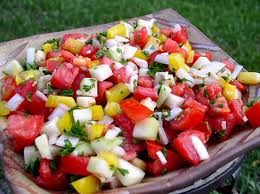 If I had a nickel for every time someone asked me if it was safe to plant tomatoes this last week, well, I’d have a large pile of nickels. Unless they lived in Delaware, I told them “no”.
If I had a nickel for every time someone asked me if it was safe to plant tomatoes this last week, well, I’d have a large pile of nickels. Unless they lived in Delaware, I told them “no”.
Tomatoes are in the warm-season vegetable category. They do best when the following three criteria can be achieved:
Transplant into soil at least 55 degrees (not yet)Day time temps of 65-90 (getting there)Nights above 50 (almost)
If you are dying to plant a garden now, focus on broccoli, cabbage, cauliflower, peas, onions, lettuce, spinch, kale, radishes, Swiss chard and the like. But even early vegetables may need some protection. The neighboring farm has long rows of cole crop vegetables and onions planted into black plastic to warm the soil, and then covered with light frost cover suspended over the rows and held down at the ends and sides with cement blocks. This gives new transplants protection from drying, whipping winds. This is a great way to get young plants established, especially if they have not been hardened off outside first.
When I was a kid, the first time I saw a Wall o Water I was amazed. If you must plant your tomatoes now to ensure you are the first in your neighborhood with the delicious red treasures, I would try these. If nothing else, they are kind of fun.
Here is the general procedure: Fill the circular tubes half-full of water to make a tee-pee around where young plants will go for a week to warm the soil. Then plant the young tomato (or pepper) into the warmed soil. As soon as it grows out the top of the teepee, completely fill the tubes with water to form a circular wall. Remove the walls once the frost-free date is past and plants are filled in. The claim is the plastic water- tubes provide insulation and protection down to 16 degrees, and when used appropriately, will allow you to start tomatoes in the ground 6 weeks before your last frost date.
A heavy freeze will kill tomatoes, and a light frost will nip growing tips and flowers, but not kill the plant. According to the National Weather Service using temperatures collected around PA, Lancaster Countyon average, has our last freeze April 11th. Our absolute last frost isn’t until into mid-May. So what that means to me is I wouldn’t plant my tomatoes just yet. Dad always said check the 10-day weather forecast on the 20thof April and no nights below 45, you were pretty safe.
The number of days listed on the seed packets, or advertised at the greenhouse will tell you the length of time from transplanting until harvest. Early, small fruited varieties like ‘Early Girl’ or ‘Fourth of July’ are ready to harvest 45-55 days after planting. They often produce fruit by the end of June or early July. Cherry tomatoes usually take two months from planting, whereas the larger beefsteak types can take up to three months.
There are some vegetables you are just better off waiting on. Peppers wait to plant until Mother’s Day, and cucumbers, squash and melons even a little after that. Summer will be here before you know it. Let’s not rush spring.

